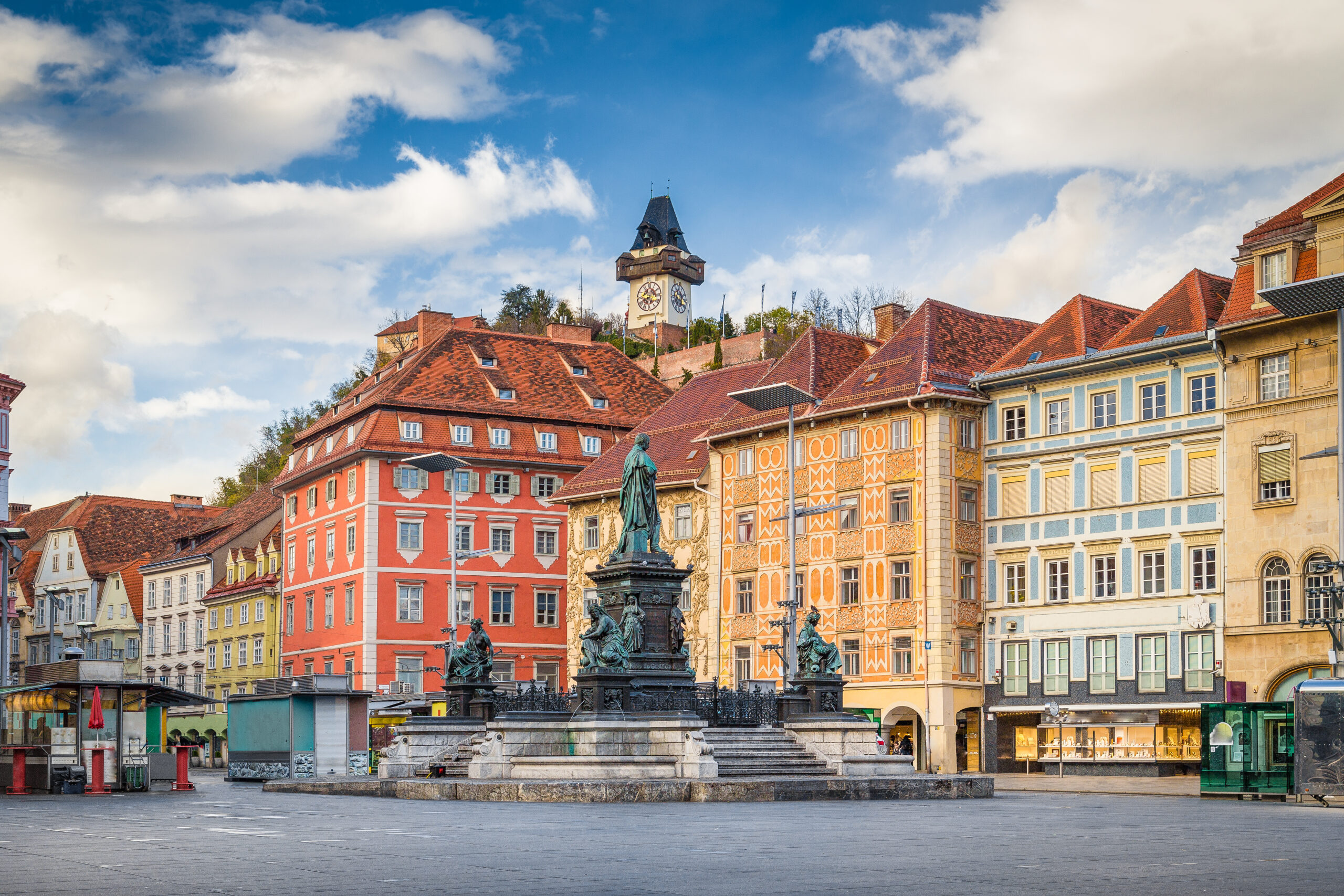Vienna, the Tyrolean Alps, and perhaps Salzburg with its Mozart connections—these are the places typically associated with Austria. Yet the country offers much more, and when it comes to cities, Graz is far too often overlooked. As Austria’s second-largest city after Vienna, Graz truly shines in autumn.
Where is Graz?
Home to 300,000 residents, Graz sits in southeastern Austria in the state of Styria, just a few miles from the Slovenian border and about two hours by road from Vienna.
Here you’ll find Austria’s plains (or nearly so), foreshadowing what nearby Hungary calls the puszta—vast flat expanses of wild grassland reminiscent of America’s Midwest plains. This is a different Austria, far removed from the tourist-packed mountains of Tyrol, though those aren’t far away either.
A Historic Center Worth the Trip Alone
Graz is a city rich in history, culture, and traditions, home to several universities recognized throughout Austria and beyond. You’ll discover—or at least sense—all of this through its old town, which tells the story of the various influences the city has experienced since the Middle Ages.
The historic center earned UNESCO World Heritage status in 1999 and absolutely shouldn’t be missed.
Wander through its maze of narrow streets and medieval houses lined with shops, restaurants, and bustling cafés. Take time to explore must-see sites like Hauptplatz, the city’s beautiful main square, the somewhat austere Saint Giles Cathedral, and the Clock Tower. It’s a journey through time and architecture spanning multiple eras that you won’t regret.

Four More Can’t-Miss Spots in Graz
Eggenberg Palace
This magnificent primarily Baroque palace sits a few miles from Graz’s center. Built in the 17th century on a medieval foundation, its interiors are remarkable and richly decorated, especially the unforgettable state rooms. The surrounding 45-acre landscaped park is also worth exploring and houses the regional archaeology museum.
Kunsthaus Graz
This contemporary art museum was built in 2003 when Graz served as European Capital of Culture. With its distinctive architecture along the Mur River running through the city, it has become one of Graz’s landmarks. The museum features rotating exhibitions of multidisciplinary art blending design, video, multimedia, and everything contemporary art has embraced in recent decades.
In a similar vein, check out Murinsel (“Island on the Mur”). This giant shell-shaped structure in the middle of the Mur River connects both riverbanks with two walkways. It was also created in 2003.
Landeszeughaus Museum
If you’re into medieval weapons and armor, old cannons, swords, antique firearms, and everything related to the military arts of the Middle Ages and beyond, this is your place. With 32,000 pieces from around the world, this museum ranks among the world’s largest specializing in historical military artifacts.
The Schlossberg
This is where you’ll want to go for city views and a lovely panorama. This hill rising to 1,558 feet overlooks Graz by a good 330 feet. You can reach it from the center on foot, by elevator, or via funicular.
Don’t bother looking for the castle that might be there (Schlossberg means “Castle Mountain”). It’s long gone, unlike the (old) Clock Tower, which over time has become the city’s emblem.
A Drive Through Styrian Tuscany
It’s not quite Italy, but it comes pretty close.
South of the city stretches a region of rolling landscapes dotted with woods and meadows, where you’ll also discover vineyards and picturesque small villages that give the area its charm. The route is popular, and visitors come to enjoy traditional taverns (called “Buschenschenken”) scattered throughout the area to sample local wines and traditional cuisine typical of this part of Austria.

Practical Information for Graz
Getting to and Around Graz
Given its location and proximity to Vienna (112 miles), Graz is easily accessible by train, bus, and car from throughout Europe.
While the city’s airport handles some regular flights, primarily to and from Germany, it mainly offers vacation destinations for regional residents with seasonal charter flights. Bottom line: if you’re flying in, aim for Vienna rather than Graz.
Once there, if you drove, leave your car at a parking lot and use public transit (buses, trams) to get around. Or even simpler—walk or bike, since interesting sites aren’t necessarily far apart in the city.
Where to Stay in Graz
Like all major European cities, Graz offers a wide range of accommodations: numerous hotels across different price points, guesthouses, apartment rentals through the usual platforms, and campgrounds on the outskirts. Plenty of choices for all tastes and budgets.
Top pick: For hotels, based on positive reviews, in the mid-range category with full services, the winner is—or rather winners are—the JUFA chain locations in Graz (two properties) and throughout Austria.
Dining and Nightlife in Graz
As usual, you’ll find the most options for dining and nightlife in the historic center. For shopping, head to Herrengasse. Starting from Hauptplatz (the main square), it’s the city’s most touristy and commercial street.
Info: www.graztourismus.at

